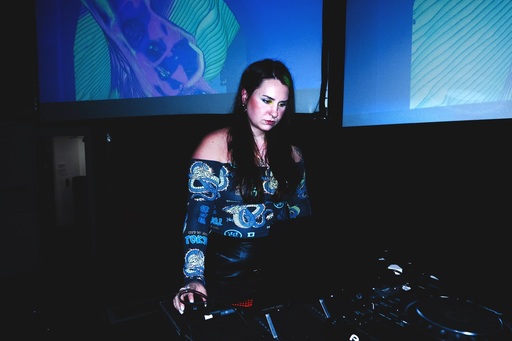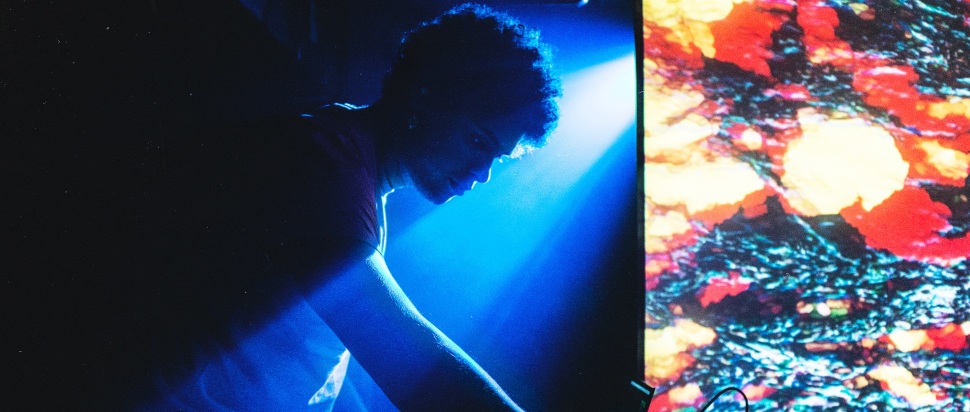The Practice and Proliferation of Visual Artistry
We meet some of Scotland's leading digital artists and VJs to learn more about the optical artistry involved in melding the production values of the mainstream and the underground to create immersive club environments
Niki Cardoso Zaupa – hailing from Vicenza in Italy, now studying at The Glasgow School of Art – began VJing in the city with experimental electronics collective Pink Noise, in 2020. Learning TouchDesigner, in tandem with a run of solo gigs – celebrating DIY immersion techniques – led to the birth of the audio-visual project Moventia, involving collaborations with the esteemed A Cut Above, Kelburn and co:clear.
On being a video jockey (VJ), Zaupa says, “there’s a dependency on the sound… you adapt yourself to follow it,” alluding to the shared responsibility between DJ and VJ in serving a function within dance-centric contexts. But it’s not only a feedback loop between sonic and visual: “the DJ influences the VJ, who visualises content, and the crowd gets fired up,” completing the self-propelling circuit. For the pupil of Interaction Design, it’s about “how people interface with elements through the aid of computation.”
Utilising Kinect Sensors and Leap Motion controllers, audience movement is monitored – “that motion is just numbers that I can use to modulate something,” explains Zaupa. Enjoying the advent of genre-fluid events, he scavenges Internet Archive, selecting “strange textural found footage” as source material to “manipulate and re-contextualise according to any situation.” He compares it to training on an instrument, “so you can trigger sweet spots whenever you need them,” as he did in late 2023 for Conna Haraway’s co:clear series. Taking place at The Dream Machine, a square venue boasting four projectors, his piece for co:clear was immersive to the extreme. “You can't get more immersive than that," he says, “in Glasgow at least… maybe Las Vegas’s Sphere, but, we did it first, okay?” Highlighting small-scale budgeting, he adds: “It's a creative limit that can help from a problem-solving point of view.” For DUALISM at The Art School, a holographic effect was achieved in utilising debris netting from construction sites – “it’s super cheap, semi-transparent and fire resistant… it works a charm.”
Tom Scholefield studied Visual Communication at The Glasgow School of Art, where he now introduces students to TouchDesigner while hosting the likes of Autechre, Warp and Modeselektor. At present he largely tours his A/V show as multimedia artist and musician Konx-Om-Pax, having previously released a series of stellar Planet Mu projects, alongside collaborations with Mogwai’s Stuart Braithwaite.
Exploring the latest performance for local synthesizer specialists Instruo, Scholefield breaks down the mechanics behind bringing his vivid animations to life with the same information used to create their vibrant sonic counterpart – “the main synth line is triggering the amplitude of patterns I made in TouchDesigner,” he says. Likening the programme to an audio-visual modular synth, he explains: “You can build whatever you want, and control it with LFOs [Low Frequency Oscillators] and envelope generators.” The patterns are a form of generative art, employing combinations of Perlin or Simplex noise, subsequently pixelated and displaced to create feedback systems “like old traditional video synth art from the 70s”, via digital methods. Scholefield finds the combinations of shapes and shades soothing, opting for abstract forms in conjuring up ideas. “You don't have to spell it out for people, it's more about feeling rather than trying to intellectualise.”
Outside of solo projects, Konx-Om-Pax cherry-picks collaborations, like past kaleidoscopic partnerships with Hudson Mohawke and Rustie. “I like to work with a shared vision,” he explains, preferring it to “trading a bunch of random visuals indiscriminately throughout a night.” Teaming with Dekmantel’s Nadia Struiwigh on LP artwork, they now double down on a new A/V show. The Dutch artist sends thorough mood boards, to which Scholefield can quickly sketch ideas, screen record them and share via WhatsApp. “That's why I moved into real-time animation, it's instant… I’ve spent half my life waiting for things to fucking render.”
While acknowledging the likes of Aphex Twin affiliate weirdcore and A/V duo 404.zero in paving paths where visual artists can gain recognition, he emphasises the overall difficulty in being valued, particularly in Glasgow and “especially if you're not a man.” Together with teaching more Visual Music Workshops in the months ahead, Scholefield is learning Unreal Engine amidst “a community of designers using computer game technology to bring 3D ideas to life.” Primarily using Houdini and Cinema 4D thus far, he adds that “I'm at the stage of joining everything to talk to each other… future projects are going to be way more intense to look at.” He's currently working with Cryptic to bring a 30-minute A/V piece to Glasgow’s Sonica Festival in September. “It's probably the closest thing I've ever had to creating something with a narrative,” he tells me…“I think I’m a frustrated filmmaker who hasn't made a film yet.”

vnc.ptk. Image credit: Jean Uzheng.
Veronica Petukhov, an Italo-Ukrainian digital artist, works via Edinburgh across an array of fronts, as one half of muto major together with Samm Anga, powerpot beside Inez, and vnc.ptk – the moniker under which she’s lit up the Cowgate, VJed for Microsteria at Summerhall, and produced Dixon’s Boiler Room animation.
Graduating from Gray’s School of Art in Aberdeen, where she established an interest in VJing and net.art aesthetics in the third year of Contemporary Art Practice, Petukhov curated an exhibition at The Tunnels just prior to the pandemic. Projected visuals soundtracked by DJs took to the stage in the main room, while friends displayed digital art installations in the other – “it was like a creative hub," Petukhov explains, "people were walking around the showcase and then went for a dance.” Petukhov found the pandemic to be a self-graduation of some sort: “Everything I do now, I taught myself through YouTube tutorials, internet forums and books.” Despite the loss of physical venues in which to practise, the increase in club-adjacent live streams provided plentiful opportunities to develop her internet-inspired 3D animation style, backdropping local DJs, promoters and labels with the use of green screens. Three years later, she was billed at Hanoi’s Monsoon Festival, “going from home streams on the computer to being flown out to Vietnam,” she adds. Partnered with local artists, combining synthesisers with recordings of traditional throat singers in the North alongside sculptures by Heather Lander, Petukhov created The Field of Heritage, which will return to Glasgow at Sonica in September.
Noting the evolution of and accessibility to technology as a means of “enriching the club experience, with artists from different backgrounds bringing new styles and aesthetics”, Petukhov works with an awareness of the funding that female and queer-oriented collectives lack. She mentions the visual versatility of home products like mosquito mesh. “If you’re smart about what and how you're using it… you can always make something cool.”
Jamie Wardrop is a Glasgow-based digital artist toeing the line between dance, theatre and clubbing. Having worked with Funktioncreep, Marc Brew, and the National Theatre of Scotland, he’s been responsible for the creation and projection of live visuals at T in The Park, Creamfields, and even for former First Minister Nicola Sturgeon.
Working to a strict brief in theatre evokes new styles, which he then “recycle[s] in the club the next night in a completely different way.” Reminiscing about early influences from Death Disco at The Arches, Wardrop recalls, “I saw visuals could be this playful thing, setting the tone for what a night might be.” In his experience on the festival circuit, however, “VJs get little to zero communication with DJs before going live… we never meet them afterwards either,” only interacting with management. “We’re these weird unicorns," he says, "roaming around in a land most do not understand.”
Sometimes provided only a static PNG logo to work with, Wardrop makes an analogy to sourdough. “You whip it up into some sort of state, leaving it to spawn in the computer” before further decorating. So even with limited starter material, “the power of the software means you can start with nothing and turn it into something,” he says, binding you only to the limitations of your imagination. But sometimes with techno, simplicity is key. “Minimalism is something I have to watch, because I'm naturally a decorator.”
Despite his love of urban brutalism, Wardrop grew up in Stirling’s countryside, and his current work is inspired by and seeks to spread ecological awareness. Sparking conversations surrounding the state of the planet with Strange Loop, alongside Sita Pieraccini, the pair combine live feeds from four microscopes varying in resolution and magnification of plant architecture and cellular pattern “in a quantum way of focus, where something starts happening.” Showcasing the project at Kelburn 2023, he explains that “we did it for four hours… by the end, it was like an organic microscope botanical rave.” Whether dancefloors are an environment to be confronting climate change, Wardrop’s interested in navigating crisis without bringing a downer. “There’s something incredibly important, in this time, about people gathering en masse… there’s a transmission of feeling within that.”
